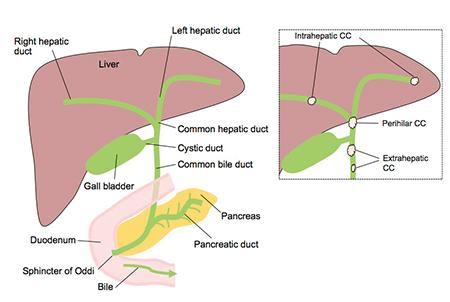Cholangiocarcinoma Defined
What is cholangiocarcinoma?
Cholangiocarcinoma, or bile duct cancer, arises within the biliary system – from the tissues of the common bile duct outside the liver or its branches within the liver.
The biliary system explained
The biliary system includes the network, or tree-like structure, of ducts within the liver and the common bile duct outside the liver.
Within the liver the smaller ducts, similar to capillaries, drain bile* from the cells of the liver into larger and larger branches. The right and left hepatic bile ducts inside the liver collect the bile, and join outside the liver to form the common bile duct (extrahepatic bile duct), which carries the bile from the liver to the gall bladder and down to the small intestine.
The gallbladder acts as a reservoir to hold bile until food reaches the small intestine. It is attached by a small duct, called the cystic duct, to the common bile duct about one-third of the way down the common bile duct from the liver.
*Bile is made in the liver and stored in the gallbladder. It helps to break down fats found in foods, and to rid the body of waste material filtered out of the bloodstream by the liver.

Cholangiocarcinoma may affect any part of the bile ducts
Depending on where the cancer begins, cholangiocarcinoma is categorized as follows:
Intrahepatic – affecting bile ducts within the liver.
Extrahepatic – affecting the bile duct outside the liver.
Hilar (Perihilar or Klatskin tumours) – affecting the junction of the left and right hepatic ducts.
Distal – affecting the bottom portion of the bile duct, near to the connection with the small intestine and pancreas
Adenocarcinoma, cancer arising from the mucus glands lining the inside of the bile ducts, is the most common type of cholangiocarcinoma, accounting for up to 95% of all cases.
May 2013
Cholangiocarcinoma







